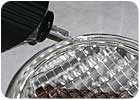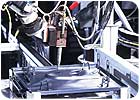A New Generation of Hot-Melt Sealants
Silicone sealants are now offered that combine the advantages of a pressure-sensitive adhesive (PSA) with the high performance of a structural, neutral-cure silicone sealant.


Always looking for ways to improve productivity and quality, manufacturers are turning to sealants as an alternative to bolts, screws, and rivets that often loosen, leak or corrode over time.
In the past, traditional sealants were unable to substitute mechanical fasteners due to limitations in substrate wetting, long-term performance and cure time. New developments in reactive hot-melt sealants are overcoming these issues to present a unique opportunity for manufacturers.
To address these issues, Dow Corning developed a new generation of hot-melt silicone sealants that combines the advantages of a pressure-sensitive adhesive (PSA) with the high performance of a neutral-cure silicone sealant. These hot-melt silicone sealants provide immediate and excellent adhesion to substrates such as metal, wood, painted surfaces and glass, as well as low-energy surfaces such as PVC, ABS®, PE, Teflon®, and many other plastics.
When first applied at temperatures of 120-130°C, the sealant is as strong as double-sided tape, with adhesion of 6-18 psi. Within 30 seconds, the silicone begins cooling and the viscosity rises to offer “instant bonding.” This adhesive bond strength is from both the viscosity rise and the pressure-sensitive adhesive character of the material. The PSA is “built into” the sealant to provide instant green strength, which allows products to move from one processing step to the next with no wait time. This can reduce downtime and eliminate the bottlenecks in manufacturing caused by cure times associated with other sealants, such as typical room temperature vulcanized (RTV) elastomers.
Once cured, the sealant has a tensile strength of 350-780 psi, but remains flexible at temperatures well below 0°F and doesn’t break down at high temperatures.
Even after crosslinking, silicone hot-melt sealants remain flexible due to their silicone-oxygen backbone. Because the silicone is not adhered at focused points, as with traditional fasteners, the stress is distributed along the bond line, and the flexibility of the sealant absorbs much of the stress at high and low temperatures.
Silicone hot melts demonstrate excellent surface wetting characteristics, do not require priming or surface activation, and are suitable for most substrates, including PVC, aluminum, wood, and plastics. Hence, hot-melt sealants have an growing number of uses, including marine, automotive, and sports and leisure applications, as well as solar cells, circuit boards, and home and industrial appliances. For home and industrial appliances, hot melts are ideal for sealing air and water in or out of ovens, blenders, mixers, sinks, coffee pots, stovetops, kitchen equipment, refrigerators, washing machines, dishwashers, and steam cleaners.
A major advantage of silicone hot-melt sealants is their ease of use, allowing manufacturers to devote more time and attention to customers’ needs. Hot-melt sealants improve productivity because they are designed for easy processing with automatic equipment, are not heat activated, and offer a long pot life and open time. This allows for easy adjustment of the parts being bonded.
Silicone hot-melt sealants are very durable and have great longevity. They resist environmental factors over time because they are virtually unaffected by long-term exposure to ultraviolet rays or temperature extremes. In addition, they meet volatile organic compound (VOC) standards and are available in ultra clear.
To meet increasing application demands for hot-melt silicone sealants, Dow Corning is adding several new formulations that have improved creep resistance, higher viscosity and greater flowability. One patented technology is designed to provide better resistance to low static shear and to have a lower application temperature. At the same time, this new technology’s mechanical properties will be closer to “standard” silicone sealants, meaning that it will have better resistance to cohesive failure and creep.
Hot-melt technology continues to change and improve in response to industry trends and demands, and is an excellent choice for manufacturers looking for improved adhesion, an alternative to mechanical fasteners, fast cure times, and low labor costs.
For more information, contact Dow Corning at www.dowcorning.com.
Links
Looking for a reprint of this article?
From high-res PDFs to custom plaques, order your copy today!



